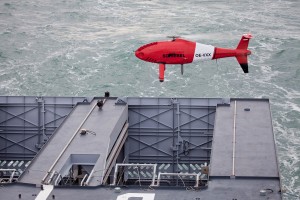
The Camcopter S-100 lifts off the rear deck of the French Navy OPV L’Adroit during initial compatibility trials earlier this month. (Schiebel photo)
Operating at the cutting edge of technology, the S-100 successfully completed a series of flights and trials onboard the L’Adroit OPV at the beginning of November, under the command and control of the French Navy. L’Adroit is believed to be the first ship ever to be specifically designed to operate Unmanned Vehicles and has been fitted out to operate the maritime proven Camcopter S-100. Thanks to its modular system architecture, the unmanned helicopter could be easily managed.
« With the unmanned airborne system it is possible to gather information without tiring the crew and without exposing the crew towards an enemy and / or bacteriological and / or chemical hazards or also to act as communication relay. » said DCNS OPV Manager Mr. Denis Menage.
During the four days of operation in the Bay of Biscay, the Camcopter carried out eleven flights and 89 deck landings using a harpoon developed by Schiebel. As part of the trials, the S-100 used its electro-optical and infrared sensors to identify exercise potential threats such as small boats. It was shown that the UAS significantly increases the capability of the ship and the missions conducted during the trials demonstrated its high potential for surveillance, harbour and costal patrol, environmental protection, intelligence gathering, drug interdiction, anti-piracy tasks, as well as supporting search & rescue operations.
« This versatile and very capable UAV can fly a complex mission as planned, without any direct interaction from the operator it is fully automatic. Its positioning systems (a combination of GPS and inertial measurement) guarantee precise navigation and stability, necessary conditions for the accurate landing on a moving platform at sea,” a naval spokesman supplemented.
We believe that embarking a tactical rotary UAS such as the Camcopter S-100 onboard such a ship will provide a step-change in its surveillance and reconnaissance capability in the future. The missions conducted during these trials aptly illustrate this enormous potential. Given the fact that many Navies seem to be focusing more on procuring smaller ships for future operations, coupled with the fact that indigenous manned helicopters are often too expensive, opens the door for UAS, such as the S-100.
This potential capability gap in terms of intelligence, surveillance and reconnaissance (ISR) is where the S-100 fits in. commented Neil Hunter, Sales Director for Schiebel and retired Naval Commander.
Schiebel s Camcopter S-100 Unmanned Air System (UAS) is a proven capability for military and civilian applications. The Vertical Takeoff and Landing (VTOL) UAS needs no prepared area, supporting launch or recovery equipment. It operates day and night, under adverse weather conditions, with a beyond line-of-sight capability out to 200 km, both on land and at sea.
The S-100 navigates via pre-programmed GPS waypoints or is operated with a Pilot Control Unit. Missions are planned and controlled via simple point-and-click graphical user interface and high definition payload imagery is transmitted to the control station in real-time. Using « fly-by-wire » technology controlled by a triple-redundant flight computer, the AV can complete its mission automatically.
Its carbon fiber and titanium fuselage provides capacity for a wide range of payload/endurance combinations up to a service ceiling of 18,000 ft and, in the standard configuration, carries a 75 lbs/34kg payload for over 6 hours.
Founded in 1951, the Vienna-based Schiebel Group of companies focuses on the development, testing and production of state-of-the-art mine detection equipment and the revolutionary Camcopter S-100 Unmanned Air System (UAS). With headquarters in Vienna (Austria), Schiebel now maintains production facilities in Wiener Neustadt (Austria), and Abu Dhabi (UAE), as well as offices in Washington DC (USA), and Phnom Penh (Cambodia).
Extrait de Defense&aerospace.com (Source: Schiebel; issued Nov. 29, 2011)

